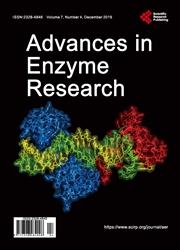Cooperative binding of calcium ions modulates the tertiary structure and catalytic activity of Matrix-Metalloproteinase-9
引用次数: 3
Abstract
To ascertain the molecular basis of Ca2+-mediated activation of matrix metalloproteinase-9 (MMP-9), we determined the accessibility of tryptophan residues to externally added acrylamide as quencher in the absence and presence of the metal ion. The steady-state and time resolved fluorescence data revealed that MMP-9 possesses two classes of tryptophan residues, “exposed” and “buried” which are quenched by the collisional rate constants (kq) of 3.2′ 109M-1.s-1 and 7.5′ 108M-1.s-1, respectively. These values are impaired by approximately two and three-fold, respectively, in the presence of 10 mM Ca2+. The Stern-Volmer constants (Ksv values) predicted from the time resolved fluorescence data (in the absence of Ca2+ ) satisfied the dynamic quenching model of the enzyme’s tryptophan residues. This was not the case in the presence of Ca2+ ; the steady-state acrylamide quenching data could only be explained by a combination of “dynamic” and “static” quenching models. A cumulative account of these data led to the suggestion that the binding of Ca2+ modulated the tertiary structure of the protein by decreasing the dynamic flexibility of the enzyme, which is manifested in further structuring of the enzyme’s active site pocket toward facilitating catalysis. Arguments are presented that the binding of Ca2+ at distal sites “dynamically” communicates with the active site residues of MMP-9 during catalysis.钙离子的协同结合调节基质金属蛋白酶-9的三级结构和催化活性
为了确定Ca2+介导的基质金属蛋白酶-9 (MMP-9)活化的分子基础,我们确定了色氨酸残基在没有和存在金属离子的情况下对外部添加的丙烯酰胺作为猝灭剂的可及性。稳态和时间分辨荧光数据显示,MMP-9具有“暴露”和“埋藏”两类色氨酸残基,它们被3.2 ' 109M-1的碰撞速率常数(kq)猝灭。s-1和7.5 ' 108M-1。s - 1。在10 mM Ca2+的存在下,这些值分别受到大约两倍和三倍的损害。从时间分辨荧光数据(在没有Ca2+的情况下)预测的Stern-Volmer常数(Ksv值)满足酶的色氨酸残基的动态猝灭模型。在Ca2+存在的情况下不是这样;稳态丙烯酰胺猝灭数据只能通过“动态”和“静态”猝灭模型的结合来解释。对这些数据的累积分析表明,Ca2+的结合通过降低酶的动态灵活性来调节蛋白质的三级结构,这表现在酶的活性位点口袋的进一步结构中,以促进催化。有观点认为,在催化过程中,Ca2+在远端位点的结合“动态”地与MMP-9的活性位点残基通信。
本文章由计算机程序翻译,如有差异,请以英文原文为准。
求助全文
约1分钟内获得全文
求助全文

 求助内容:
求助内容: 应助结果提醒方式:
应助结果提醒方式:


